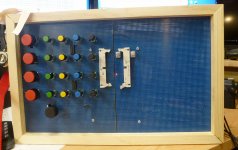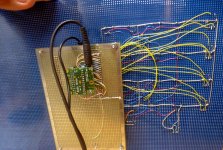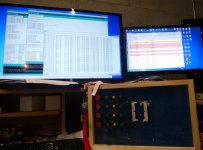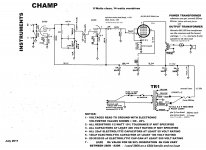A while ago I was going through the $1 valve list on ESRC. I have pretty much zero background knowledge of valves, so I have to find the data sheet for each one, and look through it to see if I might be able to use it for something....language and graphics not suitable for some children...
I found the 6BK5, and thought the data sheets were promising. Like Printer2, I Googled to see if anyone was using it in a guitar amp. Google turned up some of the advertising for that amp with the foul-mouthed name.
I can't speak for anyone else, but even if that amp sounded heavenly and sold for only $50, I would not buy it. I cannot see myself buying a product built around that degree of juvenile foul-mouthed advertising and verbal abuse of potential customers, nor can I see myself using an amp with that name and those graphics where other people might see it.
I guess I wasn't Mr. Barbour's target market.
Speaking of the 6BK5, when you mentioned the power limits of the 6AQ5 in it's little 7-pin bottle, I wondered if the 6BK5 might not sound just as good, put out almost the same power, and cost even less.
That's what I was wondering about, too.Adding a tube module ... is just asking for drift.
What happens if one generates reference frequencies digitally, and then uses a PLL or something to lock a more tasty-sounding analog oscillator to that frequency? Digital pitch accuracy along with analog sound? That might be nice, though it would probably end up needing one analog oscillator for every individual note.
-Gnobuddy
I actually have an L-Pad in my DIY amp. You can see it at the right end of the amp in the photo I posted (post #1927). It's wrapped in blue painters tape to keep it from shorting to anything near it, since it's not properly secured yet. 😱
The L-pad certainly works, but I think my ears don't work so well once I turn down the volume low enough to be sure I'm not annoying neighbours. Probably the old Fletcher-Munson contours at work - lots of perceived bass and treble loss at low sound pressure levels, which seems to take away my ability to hear the "tubey" or "valvey" characteristic sound I crave in my guitar amps.
Incidentally, I apologize for my sometimes schizophrenic spelling and nomenclature - I grew up with British English, but then lived in the USA for a long time. The end result is frequent total confusion when it comes to spelling!
-Gnobuddy
Saw it but was hoping to hear some audio files. I have about 30 of them, think I got them for under $2 a piece. Will get to them at some point in time but I have other tubes to use first. Maybe an amp for my niece's husband? He needs a little more power and maybe I can get my mini-5E3 back? Sounds like a plan.
What happens if one generates reference frequencies digitally, and then uses a PLL or something to lock a more tasty-sounding analog oscillator to that frequency? Digital pitch accuracy along with analog sound?
I tried that something like 35 years ago. There used to be a chip called a top octave generator, Mostek MK50240 (older version MK5024). These were so common in the early 80's that you could get them at Radio Shack. It produced the top 12 notes on an organ keyboard by dividing a master clock (about 2 MHz) by an integer to create 12 notes in the 4 to 8 KHz range, the lower octaves were created with 12 divider chains. I used CD4040 CMOS counters. The PLL's were CD4046.
The PLL's allow for portamento (glide) and some other effects. A good "String Ensemble" clone could be built with this concept and some Bucket Brigade chips. I made one of those too. Today the MK50240 is extinct (so is Mostek) and working chips cost $$$$
The fact that all the notes are locked to the same (often crystal) reference removes the micro mistunings that cause each note to wander slightly, and create the "analog sound." There are some digital techniques that can recreate this effect. The Dave Smith Instruments Prophet 6 actually has a knob that goes from pristine digital accuracy, to warm analog slop, to total rude mistuned anarchy.
If you look at nearly all true analog VCO's, they all produce a sawtooth wave. The other waveshapes are created from the sawtooth. Most create the sawtooth in exactly the same manner. A capacitor is charged through a Constant Current Source, creating a linear ramp. Once the cap reaches a predetermined voltage, a comparator triggers a switch that discharges the cap, and the sequence repeats. The incoming Control Voltage (CV) controls the Constant Current Source, setting the charge current, and thus the frequency. Most analog synths operate on a one volt per octave logarithmic scale (1V/oct). This requires a log converter in front of the CCS. All of this is quite sensitive to temperature, especially the log converter.
It is fairly easy to replace everything except the cap with a small PIC chip, or other processor with similar characteristics. The CV from the keyboard is read by an A/D. This number determines (roughly) the CCS charge current through a D/A in the chip, but through some math, an internal counter determines exactly when to trigger the switch, discharging the cap. I built a VCO in this manner, and it works, but I am working on another way.
I believe I mentioned the Teensy board earlier in this thread. I have a small synth working entirely in a Teensy 3.2 board, but I have reached it's limits in I/O and processing power. A new, bigger, more powerful board has been in the works, and was funded in about an hour on Kickstarter a few days ago.......A bigger more powerful synth is in the works. I will start a thread when it shows some signs of life. In the mean time.....I have made a new breadboard. The left side is nearly done. No tubes yet.
Attachments
I see myself using an amp with that name and those graphics where other people might see it.
I wouldn't be seen with it either, but I'm not a young death metal guitar player either 🙂
There was another version of the same amp with rude graphics covering the entire face.
EL34 World? The Burger King 5-6-7
Didn't know of that amp, or the forum for that matter. I never heard of the 6BK6 or the 6BK8) I have used both the 6BK5 and the 6BK7.
I have a box full of tubes that were scheduled to meet with my latest breadboard for "testing." The tubes were sorted into groups with compatible pinouts to minimize socket rewiring, which left the 6BK5 near the end of the box since it has a unique pinout.
I have used the statement "EL84's ROCK, while 6V6's were born to sing the blues" before, and to some extent, that is true, when referring to vintage tubes. Some of the current 6V6GT production bears little resemblance to the original.
I built a couple amps with the 6BK5 quite some time ago when I ran across a few dozen of the tubes. I seem to remember a tone somewhere in between the EL84 and 6V6, although the OPT and speaker makes a big difference there. I think it was easy to get 20 watts from a pair, but I might have them confused with the 12AB5......Both tubes are in the same box. I sorted all my tubes by usefulness when I had to move and get rid of nearly 100,000 tubes!
I have pretty much zero background knowledge of valves, so I have to find the data sheet for each one
I got into tubes quite early, but back then there were only a few dozen common tubes that could be found at the trash dump. I knew the limits of all of them since they were free, and went back to the landfill when I extracted all their usefulness. 6L6 types were very rare in the trash, but 6V6's were common.
About 20 years ago a friend gave me over 100,000 tubes in exchange for a few days work. Many were junk, corroded, or broken, and it took me 5 years to sort through them all. You learn a lot by sorting, and looking up each number. I got rid of the thyratrons, 20KV rectifiers out of radar sets, and all the other odd stuff that would never make sound. Down to about 20K tubes, and knowing my career was on life support, I made spread sheets and began selling off tubes that I wouldn't get to in my lifetime. There is still about 5,000 that made the cut and moved 1200 miles with me.
As I am living in a small town-flat I built a practice amp just for that application. For your information I just recorded a sound sample with increasing the gain pot - and that is all. All this has been done at low power level to not disturb the neighbours.
No reverb or echo, just a microphone at about 50cm distance to the speaker, connected to my laptop and recorded with audacity.
It would be interesting to read your opinions😉
https://dl.dropboxusercontent.com/u/23791778/pub/distortion-demo.mp3
No reverb or echo, just a microphone at about 50cm distance to the speaker, connected to my laptop and recorded with audacity.
It would be interesting to read your opinions😉
https://dl.dropboxusercontent.com/u/23791778/pub/distortion-demo.mp3
Last edited:
The amp is my design. The speaker is a Jensen MOD15 (4 0hms).
I will disclose any details later, to avoid any biasing of the comments I hope to come.
I will disclose any details later, to avoid any biasing of the comments I hope to come.
Keep in mind that if you like your amp, then it's a good one by definition - for you! There are so many different musical styles, and so many different tonal preferences from guitarists - it's a very personal thing.
That said, since you asked for an honest opinion, I'll give you mine. Remember, it's just my personal taste in sound, that's all. And this is based on one single clip, which may or may not actually be enough to reveal the character of the amp.
Okay. Disclaimers out of the way.
I listened to the track using a pair of Sony circumaural headphones. My first impression is that the tone is thin, and very bright. There isn't much bass, and there seems to be a strong midrange/low treble peak.
I can't really tell how much is the amp, how much is the speaker, and how much is the guitar itself. But I wouldn't normally expect a big 15" speaker to sound that bright or thin, so it's probably a good guess that the amp itself is very bright.
I also don't hear what I think of as "tubey" or "valvey" cleans, which usually sound less thin, and less harsh or hard-edged.
As the track went on and distortion levels went up, I also found the onset of distortion a bit abrupt, and the nature of the distortion a bit harsh-sounding, particularly as the gain continued to go up.
Personally, I would find this amp fatiguing to listen to for long. But there are successful commercial amps that are bright and harsh, so there may be plenty of people who like this sound.
Based on the lack of tubey cleans, the thin and bright sound, and the fairly abrupt transition into clipping, I would guess that this is a solid-state circuit. Is it perhaps a solid-state guitar amp, or a (solid-state) distortion pedal feeding a clean solid-state audio amp?
-Gnobuddy
That said, since you asked for an honest opinion, I'll give you mine. Remember, it's just my personal taste in sound, that's all. And this is based on one single clip, which may or may not actually be enough to reveal the character of the amp.
Okay. Disclaimers out of the way.
I listened to the track using a pair of Sony circumaural headphones. My first impression is that the tone is thin, and very bright. There isn't much bass, and there seems to be a strong midrange/low treble peak.
I can't really tell how much is the amp, how much is the speaker, and how much is the guitar itself. But I wouldn't normally expect a big 15" speaker to sound that bright or thin, so it's probably a good guess that the amp itself is very bright.
I also don't hear what I think of as "tubey" or "valvey" cleans, which usually sound less thin, and less harsh or hard-edged.
As the track went on and distortion levels went up, I also found the onset of distortion a bit abrupt, and the nature of the distortion a bit harsh-sounding, particularly as the gain continued to go up.
Personally, I would find this amp fatiguing to listen to for long. But there are successful commercial amps that are bright and harsh, so there may be plenty of people who like this sound.
Based on the lack of tubey cleans, the thin and bright sound, and the fairly abrupt transition into clipping, I would guess that this is a solid-state circuit. Is it perhaps a solid-state guitar amp, or a (solid-state) distortion pedal feeding a clean solid-state audio amp?
-Gnobuddy
updating
Hi....just thought I would update the progress of the amps....I preferred the 6L6 over the 6ar6 amp so I converted the 6ar6 to 6L6...6ar6 has its own merits though
the m1120 tranny is a little shy of bass so some mods had to be done to bring the bass through...as a guitarist you want that thud when you palm mute...a must for modern sounds
but on its own it would make a surprisingly good stereo amp (my next project is a stereo amp for my I pod )
I use them as a stereo going into my Quad box (which has mono / stereo switching) and my pedal board has stereo mode as well and there is nothing cheap or nasty about the sound coming from them....totally PRO sounding 18 to 25 watts all for less than $200......there has been mention that the metal can 6L6 as dangerous or bad sounding on other threads over the net.......total crap !!
updated schem attached...enjoy 😎
Hi....just thought I would update the progress of the amps....I preferred the 6L6 over the 6ar6 amp so I converted the 6ar6 to 6L6...6ar6 has its own merits though
the m1120 tranny is a little shy of bass so some mods had to be done to bring the bass through...as a guitarist you want that thud when you palm mute...a must for modern sounds
but on its own it would make a surprisingly good stereo amp (my next project is a stereo amp for my I pod )
I use them as a stereo going into my Quad box (which has mono / stereo switching) and my pedal board has stereo mode as well and there is nothing cheap or nasty about the sound coming from them....totally PRO sounding 18 to 25 watts all for less than $200......there has been mention that the metal can 6L6 as dangerous or bad sounding on other threads over the net.......total crap !!
updated schem attached...enjoy 😎
Attachments
I'm impressed it (the M1120) can cope with 100 mA of DC current!the m1120 tranny is a little shy of bass
All of us building valve amps using voltage multipliers and audio line transformers owe a big "Thank you!" to Roly Roper of the Aussie Guitar Gearheads forum and his OzValveAmps.org website.
I never knew him other than through his posts and website, but I was very sorry to hear of his recent passing. A very smart, very knowledgable, very kind man, who enjoyed helping other people to learn.
-Gnobuddy
Thank you for your detailed reply. Certainly there is a big amount of personal taste, and you cannot discern the contribution of guitar, pre-amp, power-stage, and the speaker, and last but not least - the player.Keep in mind that if you like your amp, then it's a good one by definition - for you! There are so many different musical styles, and so many different tonal preferences from guitarists - it's a very personal thing.<snip>
The speaker is a 6.5inch Jensen MOD15, which sounds relatively soft compared to other drivers of that small size.
Anyway it sounds thin compared to a 12 inch speaker.
To make things more complicated, my strat is fitted with a buffer PreAmp that gives extended treble response.
All in all I tend to a quite clear sound that might appear harsh to others.
Later on I will repeat this test with a bigger speaker.
m1120
the m1120 does handles the current fairly easy ....barely heats up at all in SE conditions....my concern was getting bass out of them being light on iron
As I thought they are a little light on bass for guitar use.....but you can make adjustments in the tone stack....more capacitance in the cathodes etc
and it worked.....to a degree........for me its enough but for others maybe not be enough....neither do they lack for loudness....two used in stereo is giggable and most important of all......they are enjoyable to use
see the schem...if you can find a simple way to induce more bass let me know
rifraf
the m1120 does handles the current fairly easy ....barely heats up at all in SE conditions....my concern was getting bass out of them being light on iron
As I thought they are a little light on bass for guitar use.....but you can make adjustments in the tone stack....more capacitance in the cathodes etc
and it worked.....to a degree........for me its enough but for others maybe not be enough....neither do they lack for loudness....two used in stereo is giggable and most important of all......they are enjoyable to use
see the schem...if you can find a simple way to induce more bass let me know
rifraf
I repeated the test with another speaker: 10 inch eminence "Ramrod"
https://dl.dropboxusercontent.com/u/23791778/pub/distortion_demo_tramp_eminence_10inch.mp3
https://dl.dropboxusercontent.com/u/23791778/pub/distortion_demo_tramp_eminence_10inch.mp3
Last edited:
One easy way is to add a series resistor and capacitor in parallel with the existing 220k grid bias resistor of the 6L6. The other 220k resistor (going to the 0.02 uF cap) in your schematic also plays a part.see the schem...if you can find a simple way to induce more bass let me know
I'll attach a screenshot. The 82k and 4.7nF (same as 4700pF, or 0.0047 uF) are the two new components. The graph shows what LTSpice thinks the frequency response will be - a gentle bass boost, with a +3dB corner frequency at about 300 Hz. I've plotted from 80 Hz to 8kHz, which is what matters for guitar.
If you want, you can tinker with the R and C values to change the frequency response to suit your taste. Reducing the 82k will increase the total amount of bass boost, but at the cost of some overall gain loss. Reducing the 4.7nF cap will move the boost up to higher frequencies.
Keep in mind that, at higher volume levels, boosting the bass may cause the output transformer to start to saturate. Once the transformer starts to saturate, it puts out even less signal (bass, in this case). So the added bass boost may only work at lower volume levels.
But it's easy enough to try, and if you don't like it, easy enough to undo!
-Gnobuddy
Attachments
It may come to that. I've done that before, with a Zoom G3 (digital modeller / multiFX unit) as the "preamp". But my guitar strap, headphone cable, and guitar cable like to get into a power struggle whenever I try.Ever considered a rather good preamp design and a set of headphones
I don't have any wireless headphones at the moment. A couple of years ago, I tried a cheap Bluetooth pair (along with a Bluetooth transmitter) and there was so much latency that I could not stand it - you pick a note on the guitar, and hear it in the 'phones a fraction of a second later.
So I may have to get myself some better wireless 'phones eventually.
I just remembered another trick I've used in the past - putting the guitar amp on a little table, and sitting on the bed very near it, so the speaker was at my ear height, and very close (within two or three feet of my head). That way, the amp can sound very quiet to anyone else who's a little distance away, but still loud enough for me to hear well, since I'm so close to it. Sorta turns the amp into one very large almost-headphone!
-Gnobuddy
Last year I found a pair of extremely ugly plastic boombox speakers at a thrift store for a few bucks ($5, I think). Each enclosure held a small midrange and tweeter, and a slightly bigger (maybe 5 or 6 inch) "subwoofer".The speaker is a 6.5inch Jensen MOD15, which sounds relatively soft compared to other drivers of that small size.
Anyway it sounds thin compared to a 12 inch speaker.
Driven from a small class D amp, in turn fed by a small digital guitar modeller (Nux PG-2), that "subwoofer" turned out to sound reasonably good as a small, cheap guitar speaker. I think it rolls off the treble early and steeply, like most guitar speakers do, so it muffles the harshness from the solid-state modelling amp.
Definitely a fairly unusual taste in guitar tone, though Les Paul himself had the same preference you do. He even wound his own low-impedance pickups with huge coils of relatively thick wire, and routed out his stage and studio guitars to fit them.To make things more complicated, my strat is fitted with a buffer PreAmp that gives extended treble response.
There were some 1980s recordings (probably using solid-state electronics) that had that sort of thin, trebly, "Hi-Fi" guitar sounds in them. I remember a John Hughes movie with those sorts of clean guitar tones in the background music, but I can't remember which of his movies it was.
-Gnobuddy
The buffer amp contains a treble control that acts as a variable capacitor parallelled to the pickup(s). This allows tuning the resonant frequency between about 1,5 upto 6khz. I preferable use that together with the bridge pickup.
Interesting! Is that by any chance Roly Roeper's design, from the Aussie Guitar Gearheads forum? I recall that he once posted an LTSpice simulation of a circuit that used controlled bootstrapping (small amounts of positive feedback) to vary the effective capacitance seen by the guitar pickup.The buffer amp contains a treble control that acts as a variable capacitor parallelled to the pickup(s). This allows tuning the resonant frequency between about 1,5 upto 6khz.
-Gnobuddy
- Home
- Live Sound
- Instruments and Amps
- The Hundred-Buck Amp Challenge




